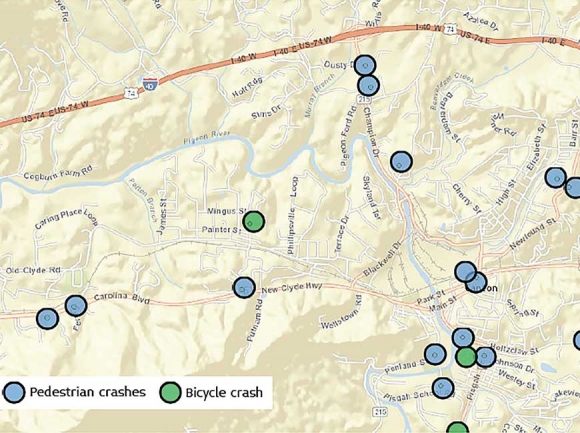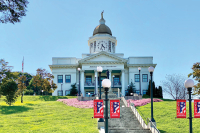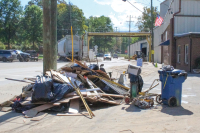Canton adopts long-term bike and pedestrian plan
 Forthcoming improvements to Canton’s bicycle and pedestrian infrastructure could help cut down on the number of accidents around town. NCDOT photo
Forthcoming improvements to Canton’s bicycle and pedestrian infrastructure could help cut down on the number of accidents around town. NCDOT photo
There are a number of reasons to walk or bike to work, to play or to shop — saving money on gasoline, experiencing the health benefits of regular physical activity, or just a general desire to stop and smell the roses — but that’s especially so in the compact, walkable communities that dot much of Western North Carolina.
With the recent adoption of a comprehensive and voluminous long-term bike and pedestrian master plan that’s as much about recreation as it is about economic development and safety, the town of Canton hopes to become the very model of what a bike- and pedestrian-friendly 21st century community looks like.
“Some of these projects will outlive my time as mayor, and that’s OK,” said Canton Mayor Zeb Smathers. “Any time we do improvements from here on out, our goal is to align those with what our bike and pedestrian plan lays out.”
The plan — more than 300 pages — was constructed over the span of almost three years with the idea of making Canton’s existing network of roads and sidewalks more amenable to walkers and bicyclists, but Smathers gives due credit to Assistant Town Manager Nick Scheuer, who came to Canton about a year ago from the North Carolina Department of Transportation’s Bicycle and Pedestrian Division.
“Nick earned his biscuit,” said Smathers. “We had very high expectations for him, not just in this realm, but Nick arrived and said, ‘Give me the ball on this,’ and I think he put it in the end zone.”
The 2009 American Community Survey says that almost 3 percent of commuters are bicyclists, and about half a percent are pedestrians; those numbers will likely grow in the coming decades, especially when plans like Canton’s begin to materialize to support those commuters.
Related Items
Largely assembled by the DOT’s Division of Bicycle and Pedestrian Transportation, the plan also took into consideration substantial input from town officials and staff, consultants and stakeholders when prioritizing facility improvements and addressing what the plan calls the “disconnected nature of the existing pedestrian network.”
The first steering committee meeting was held in November 2016 and included representatives from Bicycle Haywood NC, the French Broad River Metropolitan Planning Organization and Haywood County’s Parks and Recreation department, among others.
Days later, eight cyclists of varying skill levels rode all over town, while around a dozen others walked it — one with a baby, another with a dog; the overarching concern was how dramatically conditions could vary along the route.
Once winter had passed, in April 2017, stakeholder interviews were conducted by Asheville-based planning firm Chipley Consulting. Around the same time, a community workshop was held at the Colonial Theatre.
The steering committee then set to work, with all of the knowledge gleaned through the process up to that point, and established criteria by which to score proposed bicycle and pedestrian improvements.
The committee decided that the most valuable factors for any proposed improvement would be proximity to a school or church. Ease of implementation, proximity to downtown and safety upgrades were all second-tier factors, while proximity to parks or natural areas, segments that fill gaps and serve needy populations ranked third.
Based on that scale, a list of projects was developed. The highest scoring project was to install bike lanes on a section of Reed Street, followed closely by pedestrian and bicycle improvements to Canton’s downtown Sorrells Street Park.
And those are just the top three — there are 65 more projects, ranked and covering all quarters of the town, from Old Clyde Road to Champion Drive.
“I think what it lays out at the end of the day is that we have a short-term, long-term plan of what people want,” Smathers said.
Within the realm of government, few things are more expensive than roadway and sidewalk projects, so Canton’s ambitious plan will come with a huge price tag, even if done piecemeal over the next 18 years, as the plan suggests.
For cycling improvements, a new bike lane costs an astronomical $450,000 per mile. Even reconfiguring existing pavement markings — removing old lane markings and painting new ones — costs $18,000 per mile.
A 10-foot wide paved multi-use trail built on existing sidewalk or railbed costs $800,000 per mile, new construction of a multi-use trail runs $400,000 more than that, and pedestrian bridges are so expensive they’re priced by the linear foot — $1,800 per, in this case.
Then there’s the signs, the poles, the bike racks, the crosswalk striping and everything else that comes with a robust bike and pedestrian transportation system.
Smathers said that paying for the myriad facilities would be challenging, but not impossible. Even before the recent establishment of the Cruso Trust, which makes beautification funds available to the town, funds appropriated for infrastructural improvements have long been seen in town budgets.
“Even when I was an alderman [prior to 2017] we started investing in infrastructure — streetscape, sidewalks, paving,” he said. “These improvements will be limited based on funding, but it will be a long term initiative.”
Any improvements made by the town, however, wouldn’t just be a luxury — they’re becoming a necessity. As bikers and walkers grow in number, so do their interactions with automobiles, thus a safer environment for them is something that doesn’t really have a cost.
“The thing I have raised at many meetings is we need to do a better job with safety, especially downtown,” Smathers said. “We’ve worked very hard getting to people to come to Canton. I want them to slow down and see what we have and stick around.”
Between 1997 and 2015, a dozen pedestrians and one bicyclist were involved in crashes, according to figures provided by the Town of Canton. Two other bicyclists were involved in crashes just outside of town limits, as were several other pedestrians.
One of those incidents involved a pedestrian being fatally struck, and two of them resulted in “disabling injury.” Two crashes occurred in crosswalks, and 40 percent of all crashes involved victims over 60 years of age. The majority of them occurred during daylight hours in alleys, driveways or parking lots and the vast majority occurred during clear weather.
“Biking has risen in popularity, and you have people using the walking trails, but if you can’t keep them safe, they’re not going to use them,” Smathers said. “I think out of all of these projects, I did not see one thing that did not make things safer for our citizens and our drivers.”
Now that the plan’s been adopted, it’s been forwarded to decision makers across the state and the region like the French Broad River MPO and the North Carolina Department of Transportation’s division office. It’s also been provided to every local government in Haywood County, as well as Asheville and Candler in Buncombe County. Smathers, though, is adamant the plan doesn’t simply gather dust on some bookshelf somewhere.
“One of the hallmarks of my administration has been that we do not need more plans, we need to act on the plans we have,” he said.
A big next step is to identify shoulder-widening projects and begin advocating for them before DOT, but there are also a few “low hanging fruit” opportunities that offer a chance to demonstrate Smathers’ resolve right out of the gate.
Some of the projects are more feasible and more easily accomplished than others, despite scoring slightly lower on the steering committee’s scale. For example, the Sorrels Park improvements that came in at numbers two and three, respectively, are relatively cheap and would have an immediate impact.
The first, constructing 335 linear feet of a 6-foot wide sidewalk on the east side of Sorrells Street from Main to Park streets would only cost about $12,000. The second, a 10-foot wide paved path on the west side of the same stretch of road would cost about $20,000.
Another recommendation of the report is for the town to establish a capital improvement plan for its sidewalks that would replenish budgeted appropriations on a yearly basis.
There’s also talk of a regional task force focused on integrating intelligent bike and pedestrian planning with neighboring jurisdictions.
While all that takes shape, Smathers said, he’s focused on getting results people can see, and use, whether in Sketchers or on Schwinns.
“Bit by bit,” Smathers said, “We’ll start knocking these off, one by one.”
Read the plan
Learn more about the Town of Canton’s recently adopted bike and pedestrian master plan by reading the comprehensive 311-page report at www.cantonnc.com/proposed-bike-and-pedestrian-plan.









